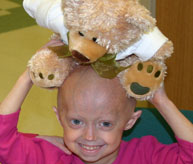The PRF Diagnostic Testing Program
 The Progeria Research Foundation, in association with a CLIA-approved diagnostics lab, is pleased to provide a DNA-based, diagnostic test for children suspected of having Hutchinson-Gilford Progeria Syndrome (HGPS).
The Progeria Research Foundation, in association with a CLIA-approved diagnostics lab, is pleased to provide a DNA-based, diagnostic test for children suspected of having Hutchinson-Gilford Progeria Syndrome (HGPS).
After an intense scientific search, the gene for Hutchinson-Gilford Progeria Syndrome (HGPS) was found in April 2003 by a group of researchers working together through The PRF Genetics Consortium. Among them were prominent researchers from institutions throughout the United States, including the National Institutes of Health, and PRF’s Medical Director Dr. Leslie Gordon. With the gene finding, it is now possible to provide a scientific test to definitively diagnose children with Progeria.
What is the Gene for HGPS?
The gene responsible for HGPS is called LMNA (pronounced Lamin A). Within this gene there is a change in one element of DNA. This type of gene change is called a point mutation. The LMNA gene makes a protein called Lamin A, which is an important protein for most cells of our bodies. Lamin A is found in the cell nucleus, and helps maintain the integrity of the cell.
Is This Disease Passed Down?
HGPS is not usually passed down in families. The gene change is a chance rare occurrence. Children with other types of “progeroid” syndromes which are not HGPS may have diseases that are passed down in families.
What is the test all about?
Previously we could only diagnose HGPS using clinical information such as an overall look and X-rays. Misdiagnosis was a frequent event. Scientists now know that HGPS is usually caused by a change of only one letter in the billions of letters that make up the human genome (DNA). That change can be seen using genetic sequencing, in which the gene is “decoded” and its sequence is determined letter by letter.
Now PRF has a genetic test that can identify HGPS. This can translate into earlier diagnosis, fewer misdiagnoses and early medical intervention to ensure a better quality of life for the children. After definitive diagnosis of Progeria, physicians and families are in need of medical treatment information for many years to come, and PRF is there to provide this important information, such as treatment recommendations that address day-to-day quality of life issues.
Moreover, with definitive diagnosis, scientists are assured that the cells they are working with (derived from blood and skin samples from Progeria children) to explore Progeria, aging and heart disease are truly Progeria cells. In the past, cells were supplied to researchers without such assurances. Thus, researchers sometimes worked with cells from non-Progeria children and this could severely affect their research results and interpretation. Through the PRF Diagnostics Program, each cell line that is donated via blood sample and skin biopsy is sequenced. There is no longer any doubt that scientific findings apply to children with Progeria. Therefore, this program facilitates PRF’s research efforts.
How do I get this test done?
The first step is for PRF’s medical director to look at the child’s clinical history to see whether or not the genetic test should be done. Then, if HGPS is a possible diagnosis, we will be in touch with you and your physicians about having this blood test done. The test is of no cost to you or your physicians. We uphold the highest standards of medical care, so that all information is kept strictly confidential.
For Physicians and Scientists:
The PRF Diagnostic Testing is done by a CLIA approved laboratory.
For further assistance, questions or problems, please contact Dr. Leslie Gordon at The Progeria Research Foundation at info@progeriaresearch.org
